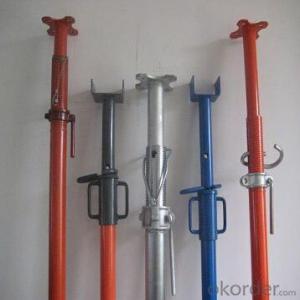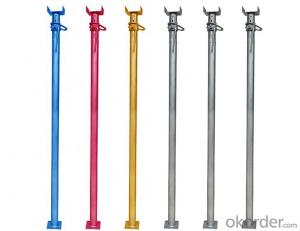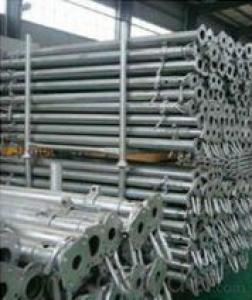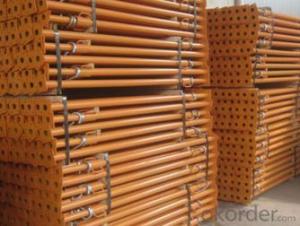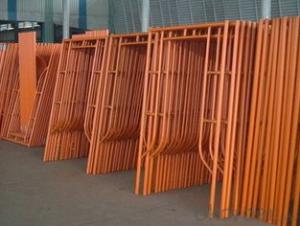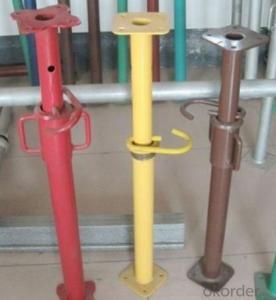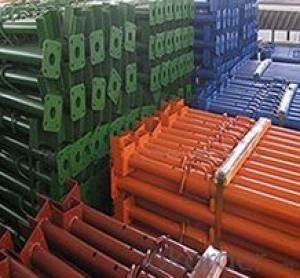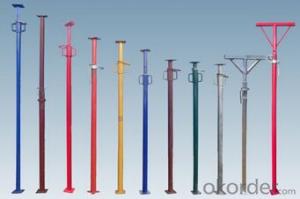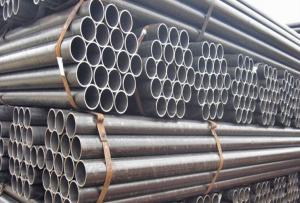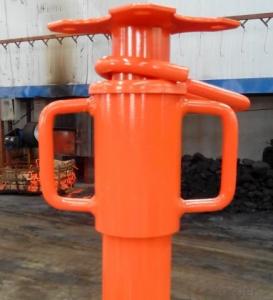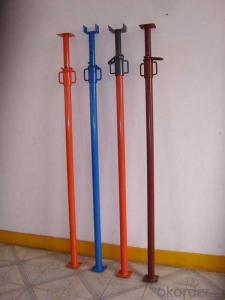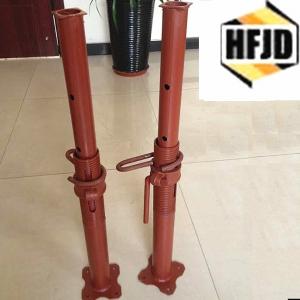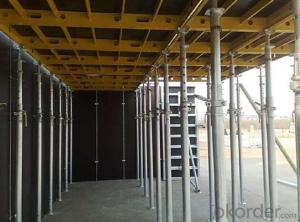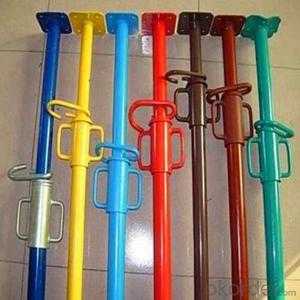Galvanized pipe support props construction steel prop
- Loading Port:
- Tianjin
- Payment Terms:
- TT OR LC
- Min Order Qty:
- 10000 PCS
- Supply Capability:
- 10000 PCS/month
OKorder Service Pledge
OKorder Financial Service
You Might Also Like
Quick Details
| surface: | paint or galvanize |
Packaging & Delivery
| Packaging Detail: | 1.in bulk 2.inbundle 3.according to customer's requirement |
| Delivery Detail: | 15-45 days |
Specifications
1.construction steel props
2.Material:Q235
3.Surface:painted/galvanized
4.Min order:500pcs
5.OD size:48mm/60mm
construction steel props
scaffolding prop
The Steel prop with reasonable and highly carrying capacity. At the construction site, it can effectively reduce the amount of prop, so that the workers can have a big operating space and can handling the materials smoothly. The speed of the set up is more 6 times than a traditional scaffolding and it can also save 70% Artificial than the traditional
The Steel prop without additional bracing and tripod-type were combined into an independent prop, stand-alone steel pillars form the basis of the whole structure
The size of the scaffolding prop
Type | Adjustable(m) | Material | Inner pipe(mm) | Outer pipe(mm) | Top/Bottom base(mm) | Surface finished |
ZSZ-3048 | 3.0--4.8 | Q235 | φ48X3.0 | φ60X3.0 | 120X120X6 | Painted/Galvanized |
ZSZ-2240 | 2.2--4.0 | Q235 | φ48X3.0 | φ60X3.0 | 120X120X6 | Painted/Galvanized |
ZSZ-2035 | 2.0--3.5 | Q235 | φ48X3.0 | φ60X3.0 | 120X120X6 | Painted/Galvanized |
ZSZ-1630 | 1.6--3.0 | Q235 | φ48X3.0 | φ60X3.0 | 120X120X6 | Painted/Galvanized |
ZSQ-2540 | 2.5--4.0 | Q235 | φ48X2.0 | φ60X2.0 | 120X120X3.5 | Painted/Galvanized |
ZSQ-2136 | 2.1--3.6 | Q235 | φ48X2.0 | φ60X2.0 | 120X120X3.5 | Painted/Galvanized |
ZSQ-1530 | 1.5--3.0 | Q235 | φ48X2.0 | φ60X2.0 | 120X120X3.5 | Painted/Galvanized |
ZSB-2540 | 2.5--4.0 | Q235 | φ48X2.5 | φ60X2.5 | 120X120X5 | Painted/Galvanized |
ZSB-2035 | 2.0--3.5 | Q235 | φ48X2.5 | φ60X2.5 | 120X120X5 | Painted/Galvanized |
ZSB-1530 | 1.5--3.0 | Q235 | φ48X2.5 | φ60X2.5 | 120X120X5 | Painted/Galvanized |
- Q: How much weight can a steel prop support?
- The weight that a steel prop can support depends on various factors such as its design, size, and quality. Generally, steel props are used as temporary supports in construction to provide stability to structures or to bear loads during construction or renovation works. The weight capacity of a steel prop can vary greatly, ranging from a few hundred kilograms to several tonnes. To determine the weight capacity of a specific steel prop, it is necessary to consider its load-bearing capacity as specified by the manufacturer. The load-bearing capacity is usually indicated on the prop itself or in the manufacturer's documentation. It is essential to follow these guidelines to ensure that the steel prop is used within its safe working limits. It is also important to note that the weight capacity of a steel prop can be affected by external factors such as the height at which it is used, the load distribution, and the stability of the ground on which it is placed. Therefore, it is crucial to consult with a structural engineer or a qualified professional to determine the appropriate size and number of steel props required for a specific application. In conclusion, the weight capacity of a steel prop can vary depending on its design, size, and quality. It is essential to refer to the manufacturer's specifications and consult with professionals to determine the appropriate weight-bearing capacity and ensure safe usage in construction or renovation projects.
- Q: Are there any safety precautions to consider when using steel props?
- Yes, there are several safety precautions to consider when using steel props. Firstly, it is important to ensure that the steel props are in good condition and free from any defects or damage before use. Inspect them for any cracks, bends, or rust, as these can weaken the props and compromise their load-bearing capacity. If any issues are found, the props should be replaced or repaired before use. Secondly, always follow the manufacturer's guidelines and instructions for the safe use of steel props. This includes using the correct size and type of props for the intended load and application. Overloading the props can lead to structural failure and accidents, so it is crucial to adhere to the recommended weight limits. Furthermore, when setting up the steel props, make sure they are properly aligned and secured. This involves ensuring that the props are plumb and vertical, and that the base plates are securely fixed to prevent any movement or instability. Additionally, consider using adjustable props with safety pins or locking devices to prevent accidental height adjustments. Moreover, it is essential to provide proper support and bracing to the structure being supported by the steel props. This may involve using additional beams, braces, or other supports to distribute the load and prevent any collapse or shifting. Lastly, it is important to provide a safe working environment when using steel props. This includes ensuring sufficient lighting, clear pathways, and keeping the area free from any obstacles or hazards that could cause trips, slips, or falls. Workers should also be trained on the proper use and handling of the steel props and provided with suitable personal protective equipment (PPE) such as gloves, hard hats, and safety boots. By following these safety precautions, the risk of accidents, injuries, and structural failures can be significantly reduced when using steel props.
- Q: How much should be the concrete strength of the main structure of the steel support to carry out the construction
- When the support is removed, it is necessary to avoid the excessive pre stress release and cause the local deformation and cracking of the structure.
- Q: Can steel props be used in sports complex construction?
- Yes, steel props can be used in sports complex construction. Steel props are adjustable and versatile support systems that are commonly used in construction projects to support structures temporarily. Due to their strength and stability, steel props can be used to support various elements of a sports complex construction, such as columns, beams, roofs, and other load-bearing elements. They are particularly useful in areas where the load-bearing capacity of the existing structure is insufficient or needs reinforcement during construction or renovation. Additionally, steel props can be easily adjusted and modified to accommodate changes in the construction process, making them an ideal choice for sports complex construction projects, where flexibility and adaptability are often required.
- Q: Are steel props adjustable in tight spaces?
- Yes, steel props are adjustable in tight spaces. Steel props, also known as adjustable steel props or steel shores, are commonly used in construction to support temporary structures such as formwork, scaffolding, or beams. These props consist of a steel tube with a threaded external portion and an internal tube that slides within the outer tube. This design allows for easy adjustment to different heights and ensures stability and load-bearing capacity. In tight spaces where there may be limited room for movement, the adjustable nature of steel props allows for precise positioning and support, making them suitable for various construction scenarios.
- Q: Are steel props suitable for supporting formwork systems?
- Yes, steel props are suitable for supporting formwork systems. Steel props are commonly used in construction projects to provide temporary support to formwork systems during the concrete pouring process. They are adjustable in height, which allows for flexibility in accommodating different formwork heights and load requirements. Steel props are strong, durable, and capable of withstanding heavy loads, making them a reliable choice for supporting formwork systems. Additionally, steel props are easy to assemble and dismantle, making them convenient to use on construction sites. Overall, steel props are considered a suitable option for providing support to formwork systems in construction projects.
- Q: What are the common accessories used for stabilizing steel props?
- To stabilize steel props, three common accessories are commonly utilized: base plates, u-heads, and bracing systems. At the bottom of steel props, base plates are typically employed to establish a secure footing and evenly distribute the load. Made from sturdy materials like steel, these plates are specifically designed to prevent the props from sinking into the ground or causing damage to the surface they rest upon. U-heads, as another prevalent accessory, are affixed to the top of the props to provide support for beams or other structural components. With their U-shaped design, u-heads enable effortless placement and adjustment of the load being supported. To ensure stability and prevent lateral movement, bracing systems are also indispensable for steel props, especially when dealing with heavy loads. Typically composed of horizontal and diagonal beams, these systems connect to the steel props, providing additional strength and stability to the overall structure. Furthermore, auxiliary accessories such as pins, bolts, and clamps may be employed to secure and connect the various components of the steel prop system. These accessories play a crucial role in ensuring the stability and safety of both the props and the entire structure they support.
- Q: How do steel props contribute to the safety of workers on construction sites?
- Steel props contribute to the safety of workers on construction sites by providing temporary support to structures, ensuring stability and preventing collapse. These props are adjustable and can withstand heavy loads, which enhances the safety of workers by preventing accidents caused by structural failure or falling debris. Additionally, steel props offer flexibility in terms of height adjustment, allowing workers to work at different levels comfortably and securely. Overall, steel props play a crucial role in maintaining a safe working environment on construction sites.
- Q: Can steel props be used in underground construction projects?
- Steel props have the capability to be utilized in underground construction projects. These props, also referred to as steel shores or steel acrow props, consist of adjustable steel tubes that are employed to provide support for temporary structures while construction is underway. They are commonly employed in a variety of construction projects, including those that occur underground. In underground construction endeavors, steel props are frequently implemented to offer support for temporary structures such as formwork, scaffolding, or falsework that are necessary during the construction process. These props are responsible for supplying vertical support and aiding in the distribution of weight from the structure above to the ground below. Steel props possess a sturdy and durable nature, and they possess exceptional load-bearing capabilities, rendering them suitable for underground construction projects. They can be effortlessly adjusted to achieve the desired height and offer dependable support throughout the entirety of the construction process. Additionally, steel props are adaptable and can be utilized in various soil conditions, including those that feature soft or unstable ground. Furthermore, steel props are known for their simplicity of installation and removal, which proves advantageous in underground construction scenarios where space and access may be limited. They can be promptly adjusted and securely positioned, enabling efficient progress to be made during the construction process. In conclusion, steel props are widely employed and serve as an effective solution for providing support in underground construction projects. Their strength, versatility, and adjustability make them a reliable choice for ensuring the safety and stability of temporary structures throughout the construction process.
- Q: How do steel props compare to steel beams?
- Steel props and steel beams are two different structural elements used in construction. Steel props, also known as adjustable steel props or acrow props, are temporary supports designed to provide vertical support during construction or renovation projects. They are typically used to support formwork, scaffolding, or any temporary load-bearing structures. On the other hand, steel beams are permanent structural elements that provide horizontal support and load-bearing capacity in buildings or bridges. Steel beams are designed to bear heavy loads and distribute them evenly across their length. In comparison, steel props and steel beams serve different purposes in construction. Steel props are adjustable and temporary, allowing for easy installation, removal, and adjustments as per the construction requirements. They are primarily used for vertical support and temporary load-bearing applications. In contrast, steel beams are designed for long-term structural support and can bear heavy loads over extended spans. They provide horizontal support and structural stability to buildings or bridges. Steel beams are typically integrated into the permanent structure and play a crucial role in distributing loads and maintaining the overall integrity of the construction. Overall, steel props and steel beams have distinct functions and are used in different contexts within the construction industry. While steel props offer temporary vertical support, steel beams provide long-term horizontal support and load-bearing capacity in permanent structures.
Send your message to us
Galvanized pipe support props construction steel prop
- Loading Port:
- Tianjin
- Payment Terms:
- TT OR LC
- Min Order Qty:
- 10000 PCS
- Supply Capability:
- 10000 PCS/month
OKorder Service Pledge
OKorder Financial Service
Similar products
Hot products
Hot Searches
Related keywords



